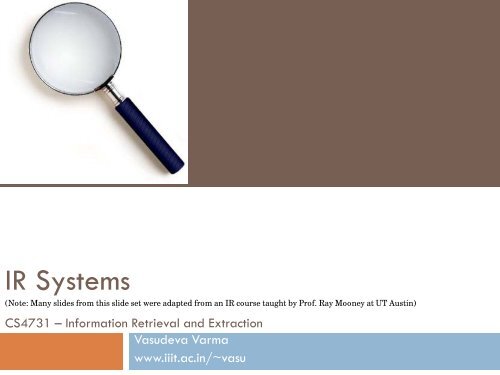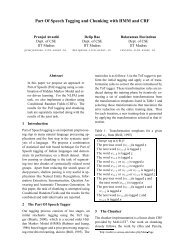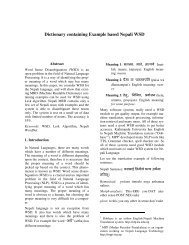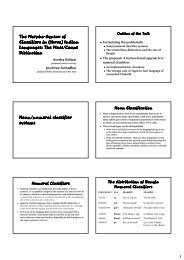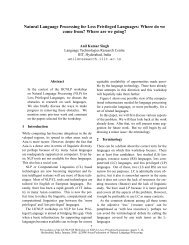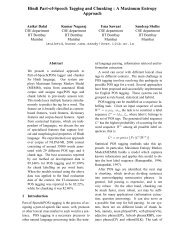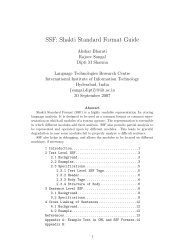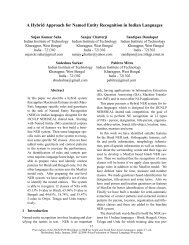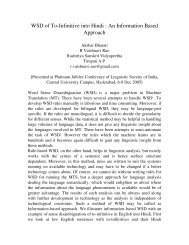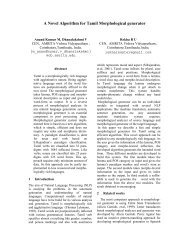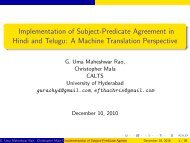Information Extraction and Retrieval - IIIT Hyderabad
Information Extraction and Retrieval - IIIT Hyderabad
Information Extraction and Retrieval - IIIT Hyderabad
Create successful ePaper yourself
Turn your PDF publications into a flip-book with our unique Google optimized e-Paper software.
IR Systems<br />
(Note: Many slides from this slide set were adapted from an IR course taught by Prof. Ray Mooney at UT Austin)<br />
CS4731 – <strong>Information</strong> <strong>Retrieval</strong> <strong>and</strong> <strong>Extraction</strong><br />
Vasudeva Varma<br />
www.iiit.ac.in/~vasu
What is <strong>Information</strong> <strong>Retrieval</strong>?<br />
<br />
<br />
<br />
Concerned firstly with retrieving relevant documents to a query.<br />
Concerned secondly with retrieving from large sets of documents<br />
efficiently.<br />
What does that generally mean?<br />
<br />
<br />
<br />
<br />
<br />
Search<br />
Filtering<br />
Organization<br />
Multiple languages<br />
Multiple media<br />
2
Approaches to IR<br />
<br />
<br />
<br />
<br />
<br />
Two types of retrieval<br />
By metadata (subject headings, keywords, etc.)<br />
By content<br />
Metadata as manually assigned information<br />
Human agreement is not good<br />
Expensive for most data<br />
Metadata assigned automatically<br />
Quality is reasonable, but not high for many applications<br />
Metadata in general<br />
Requires a priori prediction of headings, keywords, …<br />
Most successful IR approaches are content-based<br />
3
Basic approach to IR<br />
<br />
<br />
Successful content-based approaches are statistical<br />
Rather than actual “underst<strong>and</strong>ing” of text<br />
Text underst<strong>and</strong>ing effectiveness is very poor<br />
• Exception: works better in some restricted domains<br />
IR statistics used in different ways<br />
Past/concurrent queries <strong>and</strong> relevance judgments<br />
• Collaborative systems<br />
Document <strong>and</strong> query similarities<br />
4
Typical IR Task<br />
<br />
<br />
<br />
<br />
<br />
Given:<br />
Find:<br />
A corpus of textual natural-language documents.<br />
A user query in the form of a textual string.<br />
A ranked set of documents that are relevant to the<br />
query.<br />
5
IR System<br />
Document<br />
corpus<br />
Query<br />
String<br />
IR<br />
System<br />
Ranked<br />
Documents<br />
1. Doc1<br />
2. Doc2<br />
3. Doc3<br />
.<br />
.<br />
6
Web Search System<br />
Web<br />
Spider<br />
Document<br />
corpus<br />
Query<br />
String<br />
IR<br />
System<br />
1. Page1<br />
2. Page2<br />
3. Page3<br />
.<br />
.<br />
Ranked<br />
Documents<br />
7
Relevance<br />
Relevance is a subjective judgment <strong>and</strong> may include:<br />
Being on the proper subject.<br />
Being timely (recent information).<br />
Being authoritative (from a trusted source).<br />
Satisfying the goals of the user <strong>and</strong> his/her intended<br />
use of the information (information need).<br />
8
Keyword Search<br />
Simplest notion of relevance is that the query string<br />
appears verbatim in the document.<br />
Slightly less strict notion is that the words in the<br />
query appear frequently in the document, in any<br />
order (bag of words).<br />
9
Problems with Keywords<br />
May not retrieve relevant documents that<br />
include synonymous terms.<br />
“restaurant” vs. “café”<br />
“PRC” vs. “China”<br />
May retrieve irrelevant documents that include<br />
ambiguous terms.<br />
“bat” (baseball vs. mammal)<br />
“Apple” (company vs. fruit)<br />
“bit” (unit of data vs. act of eating)<br />
10
Relevant items are similar<br />
<br />
Much of IR depends upon idea that<br />
similar → relevant to same queries<br />
<br />
<br />
Usually measure query-document similarity<br />
Can consider document-document similarity<br />
“Similar” can be measured in many ways<br />
String matching<br />
Same vocabulary<br />
Probability arise from same model<br />
Same meaning<br />
…<br />
11
“Bag of words”<br />
<br />
<br />
An effective <strong>and</strong> popular approach<br />
Compares words without regard to order<br />
<br />
Consider reordering words in a headline<br />
Stocks fall on inflation fears<br />
inflation stocks fall on fears<br />
fall inflation stocks on fears<br />
fall fears inflation stocks on<br />
fall fears inflation on stocks<br />
12
How effective is IR?<br />
<br />
<br />
<br />
Anecdotal evidence from Web search says…<br />
<br />
<br />
Sometimes it works really well<br />
Most of the time it fails impressively<br />
Research systems at about 25-50% accuracy<br />
<br />
<br />
<br />
Controlled queries, document sets<br />
Near-complete relevance judgments<br />
Ad-hoc, 2-3 word queries (typical Web search)<br />
Depends what you measure (best systems, TREC 1999)<br />
• 50% accuracy in top 5 documents<br />
• 40% accuracy in top 20 documents<br />
• 30% accuracy when all relevant could have been retrieved<br />
<br />
Goes up 10% with much longer queries<br />
Seems like it could be much better...<br />
13
What could be missing?<br />
<br />
<br />
No effort to underst<strong>and</strong> the text<br />
Simple word comparison seems flawed<br />
vice president is not the same as president <strong>and</strong> vice<br />
Bill as a name is not the same as a duck’s bill<br />
George Bush is the same as President Bush<br />
A run in a stocking is different from a 5-mile run<br />
A pen for writing is not the same as a pig pen<br />
<br />
Surely IR effectiveness can be improved by addressing<br />
some of those problems<br />
14
Intelligent IR<br />
Taking into account the meaning of the words used.<br />
Taking into account the order of words in the query.<br />
Adapting to the user based on direct or indirect<br />
feedback.<br />
Taking into account the authority of the source.<br />
15
IR System Architecture<br />
User<br />
Need<br />
User<br />
Feedback<br />
Query<br />
Operations<br />
User Interface<br />
Text Operations<br />
Logical View<br />
Indexing<br />
Text<br />
Database<br />
Manager<br />
Query<br />
Ranked<br />
Docs<br />
Searching<br />
Ranking<br />
Index<br />
Retrieved<br />
Docs<br />
Inverted<br />
file<br />
Text<br />
Database<br />
16
IR System Components<br />
<br />
<br />
Text Operations forms index words (tokens).<br />
Tokenization<br />
Stopword removal<br />
Stemming<br />
Indexing constructs an inverted index of word to<br />
document pointers.<br />
<br />
Mapping from keywords to document ids<br />
I did enact Julius<br />
Caesar I was killed<br />
i' the Capitol;<br />
Brutus killed me.<br />
So let it be with<br />
Caesar. The noble<br />
Brutus hath told you<br />
Caesar was ambitious<br />
Term Doc #<br />
I 1<br />
did 1<br />
enact 1<br />
julius 1<br />
caesar 1<br />
I 1<br />
was 1<br />
killed 1<br />
i' 1<br />
the 1<br />
capitol 1<br />
brutus 1<br />
killed 1<br />
me 1<br />
so 2<br />
let 2<br />
it 2<br />
be 2<br />
with 2<br />
caesar 2<br />
the 2<br />
noble 2<br />
brutus 2<br />
hath 2<br />
told 2<br />
you 2<br />
caesar 2<br />
was 2<br />
ambitious 2<br />
17<br />
Doc 1<br />
Doc 2
IR System Components<br />
Searching retrieves documents that contain a given query<br />
token from the inverted index.<br />
Ranking scores all retrieved documents according to a<br />
relevance metric.<br />
User Interface manages interaction with the user:<br />
Query input <strong>and</strong> document output.<br />
Relevance feedback.<br />
Visualization of results.<br />
Query Operations transform the query to improve<br />
retrieval:<br />
Query expansion using a thesaurus.<br />
Query transformation using relevance feedback.<br />
18
IR Models<br />
Set Theoretic<br />
Classic Models<br />
Fuzzy<br />
Extended Boolean<br />
U<br />
s<br />
e<br />
r<br />
T<br />
a<br />
s<br />
k<br />
<strong>Retrieval</strong>:<br />
Adhoc<br />
Filtering<br />
Browsing<br />
boolean<br />
vector<br />
probabilistic<br />
Structured Models<br />
Non-Overlapping Lists<br />
Proximal Nodes<br />
Algebraic<br />
Generalized Vector<br />
Lat. Semantic Index<br />
Neural Networks<br />
Probabilistic<br />
Inference Network<br />
Belief Network<br />
Browsing<br />
19<br />
Flat<br />
Structure Guided<br />
Hypertext
Classic IR Models - Basic Concepts<br />
• Each document represented by a set of<br />
representative keywords or index terms<br />
• An index term is a document word useful for<br />
remembering the document main themes<br />
• Index terms may be selected to be only nouns, since<br />
nouns have meaning by themselves<br />
– Should reduce the size of the index<br />
– ... But it requires the identification of nouns Part of Speech tagger<br />
• However, search engines assume that all words are<br />
index terms (full text representation)<br />
20
Classic IR Models - Basic Concepts<br />
• Not all terms are equally useful for representing the<br />
document contents: less frequent terms allow identifying<br />
a narrower set of documents<br />
• The importance of the index terms is represented by<br />
weights associated to them<br />
• Let<br />
– k i be an index term<br />
– d j be a document<br />
– w ij is a weight associated with (k i ,d j )<br />
• The weight w ij quantifies the importance of the index<br />
term for describing the document contents<br />
21
Boolean Model<br />
• Simple model based on set theory<br />
• Queries specified as Boolean expressions<br />
– precise semantics<br />
– neat formalism<br />
– q = ka ∧ (kb ∨ ¬kc)<br />
• Terms are either present or absent. Thus, w ij ε<br />
{0,1}<br />
22
Drawbacks of the Boolean Model<br />
• <strong>Retrieval</strong> based on binary decision criteria with no<br />
notion of partial matching<br />
• No ranking of the documents is provided (absence of a<br />
grading scale)<br />
• <strong>Information</strong> need has to be translated into a Boolean<br />
expression which most users find awkward<br />
• The Boolean queries formulated by the users are most<br />
often too simplistic<br />
• Frequently returns either too few or too many documents<br />
in response to a user query<br />
23
Vector-based Model<br />
• Use of binary weights is too limiting<br />
• Non-binary weights provide consideration for<br />
partial matches<br />
• These term weights are used to compute a degree of<br />
similarity between a query <strong>and</strong> each document<br />
• Ranked set of documents provides for better<br />
matching<br />
24
Vector-based Model<br />
• Define:<br />
– w ij > 0 whenever k i ∈ d j<br />
– w iq >= 0 associated with the pair (k i ,q)<br />
– vec(d j ) = (w 1j , w 2j , ..., w tj )<br />
– vec(q) = (w 1q , w 2q , ..., w tq )<br />
– To each term k i is associated a unitary vector vec(i)<br />
– The unitary vectors vec(i) <strong>and</strong> vec(j) are assumed to be orthonormal (i.e.,<br />
index terms are assumed to occur independently within the documents)<br />
• The t unitary vectors vec(i) form an orthonormal basis for<br />
a t-dimensional space<br />
• In this space, queries <strong>and</strong> documents are represented as<br />
weighted vectors<br />
25
Vector Based Model<br />
j<br />
dj<br />
Θ<br />
q<br />
• Sim(q,dj) = cos(Θ)<br />
= [vec(d j ) • vec(q)] / |d j | * |q|<br />
• = [Σ w ij * w iq ] / |d j | * |q|<br />
• Since w ij > 0 <strong>and</strong> w iq > 0, 0
Vector Based Model<br />
• Sim(q,d j ) = [Σ w ij * w iq ] / |d j | * |q|<br />
• How to compute the weights w ij <strong>and</strong> w iq ?<br />
• A good weight must take into account two effects:<br />
– quantification of intra-document contents (similarity)<br />
• tf factor, the term frequency within a document<br />
– quantification of inter-documents separation (dissimilarity)<br />
• idf factor, the inverse document frequency<br />
– w ij = tf(i,j) * idf(i)<br />
27
Probabilistic Model<br />
Objective: to capture the IR problem using a<br />
probabilistic framework<br />
Given a user query, there is an ideal answer set<br />
Guess at the beginning what they could be (i.e.,<br />
guess initial description of ideal answer set)<br />
Improve by iteration<br />
28
Probabilistic Model<br />
• An initial set of documents is retrieved somehow<br />
– Can be done using vectorial model, boolean model<br />
• User inspects these docs looking for the relevant ones (in<br />
truth, only top 10-20 need to be inspected)<br />
• IR system uses this information to refine description of ideal<br />
answer set<br />
• By repeting this process, it is expected that the description of<br />
the ideal answer set will improve<br />
• Have always in mind the need to guess at the very beginning<br />
the description of the ideal answer set<br />
• Description of ideal answer set is modeled in probabilistic<br />
terms<br />
29
Probabilistic Ranking Principle<br />
• Given a user query q <strong>and</strong> a document d j , the<br />
probabilistic model tries to estimate the probability<br />
that the user will find the document d j interesting<br />
(i.e., relevant).<br />
• The model assumes that this probability of relevance<br />
depends on the query <strong>and</strong> the document<br />
representations only.<br />
• Ideal answer set is referred to as R <strong>and</strong> should<br />
maximize the probability of relevance. Documents in<br />
the set R are predicted to be relevant.<br />
30
31<br />
Thank You – Questions?<br />
Vasudeva Varma, <strong>IIIT</strong> <strong>Hyderabad</strong><br />
vv@iiit.ac.in or www.iiit.ac.in/~vasu


